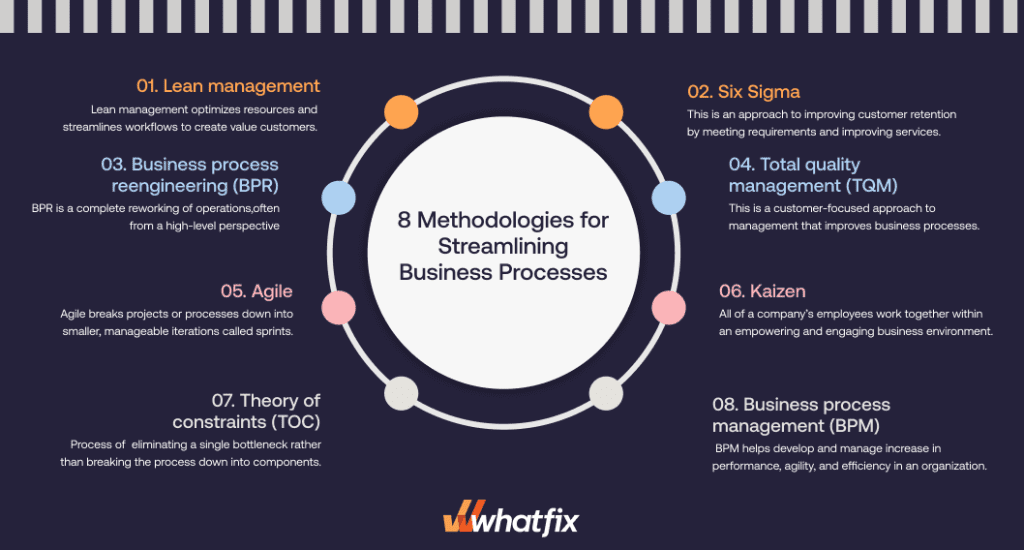Efficiency is key to business success, but many organizations struggle with processes that waste resources and hinder growth. Streamlining business processes is a strategic necessity that can transform these challenges into opportunities for enhanced productivity and profitability.
This article explores the critical importance of optimizing workflows, offering practical strategies that can help your organization achieve operational excellence. By focusing on targeted improvements and leveraging innovative solutions, you can turn inefficiencies into competitive advantages, driving sustained success in a demanding marketplace.
What Is Streamlining Processes?
A business process is a sequence of activities performed regularly to achieve a particular goal. Streamlining processes is the action of improving these day-to-day operational processes through simplification and eliminating unnecessary steps or tasks.
For example, placing a purchase order can become complicated when each department uses its own forms and deadlines. This process can be streamlined by implementing company-wide submission forms and tracking systems or automating reminders for employees to submit orders before accounting deadlines.
The actual act of streamlining processes varies depending on a company’s line of business, type of process, or operational infrastructure, but it often involves making smaller, incremental changes rather than performing large-scale overhauls. Between eliminating redundancies and removing unnecessary steps, the goal is to improve workflows and eliminate bottlenecks. Ultimately, streamlining maximizes the efficiency and effectiveness of operations while reducing risks and waste.
10 Best Practices to Streamline Business Processes
Streamlining business processes is beneficial and critical when ineffective processes affect customer satisfaction and an organization’s bottom line. Here are ten best practices to use when streamlining your organization’s business processes:
1. Map current processes
Start by mapping business processes currently in place across the area you aim to streamline. It will be helpful to visually diagram each step and include details about responsible employees and the resources they need to complete each task.
2. Tie processes to business outcomes
Once you’ve mapped each process, determine which departmental and organizational goals they contribute to. If goals have shifted since the process was implemented, and the process no longer aligns, earmark that process for improvement.
3. Identify areas of improvement with product analytics
Use data and product analytics tools from your software stack to analyze the effectiveness of your processes and use insights to identify silos, bottlenecks, digital friction, and resource waste. Determine which issues affect business outcomes most and prioritize them according to impact. This way, you can focus on eliminating the most egregious inefficiencies first.
4. Simplify and standardize
Return to your process maps and single out steps that can be automated, simplified, or cut altogether. If there are several processes with similar goals but differing steps, or if you notice one department handles a certain task more efficiently than another, take the time to standardize those processes so they follow a uniform progression of tasks. This will make it easier for employees to adopt new processes and understand how they function across the organization.
5. Leverage lean principles
Streamlining business processes through lean methodologies involves identifying and eliminating waste to enhance efficiency and value. By applying lean principles such as continuous improvement (Kaizen), value stream mapping, and just-in-time production, organizations can systematically analyze their workflows to pinpoint inefficiencies.
This approach reduces unnecessary steps, improves process flow, and optimizes resource use. Lean methodologies encourage employee involvement and feedback, fostering a culture of ongoing improvement.
By continuously refining processes and eliminating waste, businesses can achieve faster turnaround times, lower costs, and higher quality, ultimately leading to greater customer satisfaction and competitive advantage.
6. Enhance communication
Even optimized processes can fail without proper communication. Ensure that communication channels are open and utilized by your process streamlining team to prevent confusion about new process designs or rollouts. Develop plans to announce process updates and communicate further instructions with affected team members.
7. Provide support in the flow of work with DAP
Incorporate in-app messaging for processes performed with digital tools to guide employees through new, streamlined processes.
Implementing a digital adoption platform like Whafix empowers application owners and department leaders to easily craft personalized training content for users to navigate and utilize the digital tools from the outset. Whatfix offers features such as interactive walkthroughs, contextual pop-ups, and step-by-step tutorials that simplify complex workflows and reduce the learning curve. This immediate, in-app assistance minimizes errors and accelerates the adoption of new processes and systems.

8. Test the new workflow
Once your workflow has been documented, notify employees to implement the new changes in their daily work. Perform A/B testing to try out slightly different versions to ensure you optimize workflows and determine how your improved process fares in a live environment.
9. Refine and optimize where needed
As employees implement your streamlined processes, monitor key metrics and KPIs to continue revealing areas that could benefit from further streamlining. As you update processes, work with managers and other relevant teams to update training content and keep employees in the loop.
10. Focus on customer impact
Every business process must function to serve the larger purpose of providing customers with stellar service. Keep your process streamlining efforts focused by building processes with the customer in mind. Consider the impact on your business’ customers every step of the way.
Related Resources
Benefits of Streamlining Processes
Streamlining business processes leads to various benefits across your organization. Here are some of the most common benefits.
1. Increased efficiency
Efficiency is at the core of process streamlining. This reduces the time it takes employees to complete tasks and, in turn, the time it takes to reach larger-scale goals. More efficient processes also clarify employees’ expectations and purpose, keeping them engaged and productive.
2. Cost reduction
Streamlining processes often involves digitization and automation of tasks, which reduces manual work. By eliminating redundancies, bottlenecks, and silos, streamlining processes helps businesses save time and resources, which translates to large-scale cost savings.
3. Improved employee satisfaction
Process streamlining boosts employee satisfaction by reducing frustrations, creating a more transparent working environment, and promoting collaboration and teamwork. It also eliminates barriers to productivity, which empowers employees to work independently and grow more rapidly in their careers.
4. Enhanced customer satisfaction
The efficiency that comes with streamlining processes enables companies to provide faster delivery of services, with higher levels of both quality and consistency. This benefits the organization’s bottom line and allows them to pass cost savings down to customers. It also improves customer service by reducing customer wait times, improving communications, and improving the responsiveness of customer service teams.
8 Methodologies for Streamlining Business Processes
The importance of streamlining business processes is widely acknowledged across virtually every industry. Over the years, many formal methodologies have been developed to help businesses facilitate process streamlining. Here are some of the most common ones:

1. Lean management
Lean management is a business management approach based on the decades-old process management principles of the Toyota Production System: the Toyota Way. This framework centers on optimizing resources and streamlining workflows to create value for customers and eliminate overproduction, wasted time and resources, and defective products and services.
There are five core principles to the lean methodology:
-
Identify value: pinpoint the problem that needs to be solved and create a product or process to solve it
-
Map out value streams: map out workflows, including all employees and resources involved, to determine if any steps can be tweaked or eliminated
-
Create a continuous workflow: eliminate bottlenecks and interruptions to keep processes in motion
-
Develop a pull system: decrease the waste of processes to ensure optimal outputs
-
Facilitate continuous improvement: take regular measures to adjust and optimize processes
2. Six sigma
Six Sigma, or six standard deviations, was developed in the 1980s to standardize defect counting and address product quality issues. The name comes from the Greek letter sigma (σ), the symbol for one standard deviation in statistics. Six Sigma refers to an extremely high level of performance and accuracy, producing only 3.4 defects per million instances.
Six Sigma has five key principles that contribute to its goal of nearly perfect service:
- Prioritize value for the customer
- Identify the root cause of problems
- Eliminate waste and defects
- Promote collaboration among stakeholders
- Keep processes flexible and responsive
When applied more broadly to business processes, Six Sigma is an approach to process optimization and streamlining that centers on improving customer retention by meeting requirements and improving products and services.
3. Business process reengineering (RPG)
This strategy involves a full overhaul of core processes and business operations to improve outputs like quality, speed, costs, and profits. As opposed to other approaches to process improvement that focus on pinpointing and removing inefficiencies here and there, BPR is a complete reworking of operations, often from a high-level perspective. This approach tends to make the most sense for an organization facing large-scale issues with the overall management of its business processes.
4. Total quality management (TQM)
TQM is a continuous, customer-focused approach to management that uses data, strategy, and effective communication to improve business processes. One unique aspect of TQM is the premise that all of an organization’s employees are committed to reaching business goals and that this total employee involvement can only be achieved within empowered work environments.
There are eight principles central to Total Quality Management:
- Customer focus
- Total employee involvement
- Continuous improvement
- Process thinking
- Integrated systems
- Strategic and systematic approaches
- Data-based decision making
- Strong communication
5. Agile
Agile is a project management methodology that breaks projects or processes down into smaller, manageable iterations called sprints. At the end of each sprint and before the next, teams are encouraged to reflect on performance and adjust strategies if necessary. This regular feedback and adaptation creates continuous opportunities to improve and streamline processes.
Within this framework, teams create an empowering environment for effective processes by prioritizing team collaboration, customer collaboration, effective outcomes, and adaptability to change over more traditional and rigid business philosophies.
6. Kaizan
The concept of Kaizen is a combination of the Japanese words Kai (change or revision) and Zen (virtue or goodness), which come together to form a term meaning continuous improvement. Under this philosophy, all of a company’s employees work together within an empowering and engaging business environment.
Kaizen has five core principles that contribute to good housekeeping, the standardization of processes, elimination of waste:
- Know your customer (create customer value)
- Let it flow (target zero waste)
- Go to Gemba (following the action)
- Empower people (organize your teams)
- Be transparent (speak with real data)
7. Theory of constraints (TOC)
The Theory of Constraints is an approach to process streamlining that focuses on identifying the limiting factors, also called bottlenecks, impeding the desired outcome of a process and systematically removing the constraint until it no longer poses a problem.
This approach comes from Eliyahu M. Goldratt’s novel, The Goal: A Process of Ongoing Improvement. With the TOC, the focus is on eliminating a single bottleneck rather than breaking the process down into components and making improvements bit by bit.
8. Business process management (BPM)
Business process management (BPM) is a methodology that views business processes as assets to be developed and managed to increase performance, agility, and efficiency across an organization. This approach typically involves implementing a BPM software platform that uses data analytics to assess processes and provide insights for improvement.
Processes Click Better With Whatfix
The Whatfix digital adoption platform helps businesses analyze, build, and implement streamlined business processes through powerful in-app guidance and user behavior analytics. Take these steps to improve your company’s processes with Whatfix:
- Create role-based in-app guidance: With intelligent segmentation and smart contextualization, Whatfix makes it possible to deploy personalized in-app guidance so employees receive relevant learning content to improve process adoption and boost productivity.
- Support employees in the flow of work with contextual help: Program in-app support messages to be triggered when users take certain actions within the software application. This ensures that users receive useful support in their moment of need without having to navigate away to seek out solutions or submit an IT ticket.
- Analyze in-app content usage and user behavior with analytics: With Whatfix Analytics, you can track critical metrics and KPIs to monitor how your user base interacts with the software and carries out existing business processes. Use this information to identify pain points in the user journey as well as redundant or unnecessary steps in your organizational processes.
- Use this data to create additional in-app content to improve process efficiency: Now, you have everything you need to reduce user friction with improved in-app guidance and maximize your processes’ efficiency. From here, continue to monitor employee usage and process outputs, and continue streamlining processes as your organization grows.
To learn more about Whatfix, click here to schedule a free demo with us today!












